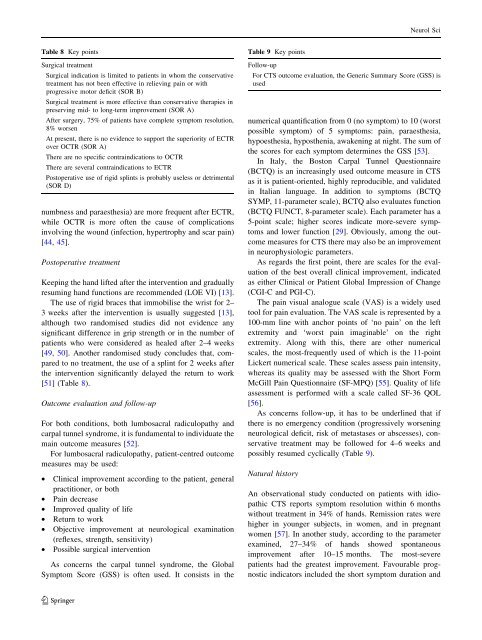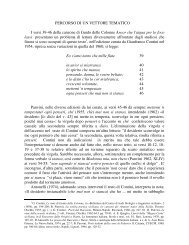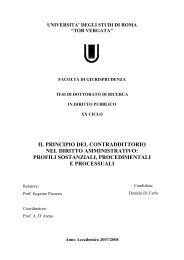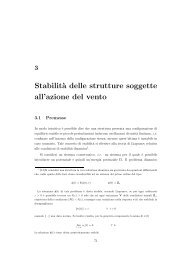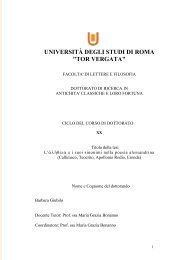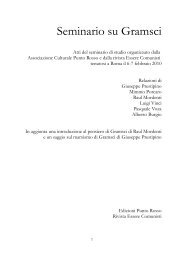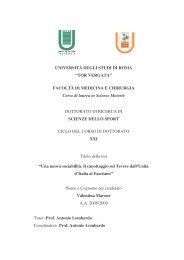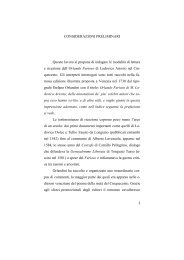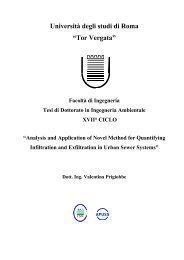Diagnosis, treatment and follow-up of the carpal ... - Home page | ART
Diagnosis, treatment and follow-up of the carpal ... - Home page | ART
Diagnosis, treatment and follow-up of the carpal ... - Home page | ART
You also want an ePaper? Increase the reach of your titles
YUMPU automatically turns print PDFs into web optimized ePapers that Google loves.
Table 8 Key points<br />
Surgical <strong>treatment</strong><br />
Surgical indication is limited to patients in whom <strong>the</strong> conservative<br />
<strong>treatment</strong> has not been effective in relieving pain or with<br />
progressive motor deficit (SOR B)<br />
Surgical <strong>treatment</strong> is more effective than conservative <strong>the</strong>rapies in<br />
preserving mid- to long-term improvement (SOR A)<br />
After surgery, 75% <strong>of</strong> patients have complete symptom resolution,<br />
8% worsen<br />
At present, <strong>the</strong>re is no evidence to s<strong>up</strong>port <strong>the</strong> s<strong>up</strong>eriority <strong>of</strong> ECTR<br />
over OCTR (SOR A)<br />
There are no specific contraindications to OCTR<br />
There are several contraindications to ECTR<br />
Postoperative use <strong>of</strong> rigid splints is probably useless or detrimental<br />
(SOR D)<br />
numbness <strong>and</strong> paraes<strong>the</strong>sia) are more frequent after ECTR,<br />
while OCTR is more <strong>of</strong>ten <strong>the</strong> cause <strong>of</strong> complications<br />
involving <strong>the</strong> wound (infection, hypertrophy <strong>and</strong> scar pain)<br />
[44, 45].<br />
Postoperative <strong>treatment</strong><br />
Keeping <strong>the</strong> h<strong>and</strong> lifted after <strong>the</strong> intervention <strong>and</strong> gradually<br />
resuming h<strong>and</strong> functions are recommended (LOE VI) [13].<br />
The use <strong>of</strong> rigid braces that immobilise <strong>the</strong> wrist for 2–<br />
3 weeks after <strong>the</strong> intervention is usually suggested [13],<br />
although two r<strong>and</strong>omised studies did not evidence any<br />
significant difference in grip strength or in <strong>the</strong> number <strong>of</strong><br />
patients who were considered as healed after 2–4 weeks<br />
[49, 50]. Ano<strong>the</strong>r r<strong>and</strong>omised study concludes that, compared<br />
to no <strong>treatment</strong>, <strong>the</strong> use <strong>of</strong> a splint for 2 weeks after<br />
<strong>the</strong> intervention significantly delayed <strong>the</strong> return to work<br />
[51] (Table 8).<br />
Outcome evaluation <strong>and</strong> <strong>follow</strong>-<strong>up</strong><br />
For both conditions, both lumbosacral radiculopathy <strong>and</strong><br />
<strong>carpal</strong> tunnel syndrome, it is fundamental to individuate <strong>the</strong><br />
main outcome measures [52].<br />
For lumbosacral radiculopathy, patient-centred outcome<br />
measures may be used:<br />
• Clinical improvement according to <strong>the</strong> patient, general<br />
practitioner, or both<br />
• Pain decrease<br />
• Improved quality <strong>of</strong> life<br />
• Return to work<br />
• Objective improvement at neurological examination<br />
(reflexes, strength, sensitivity)<br />
• Possible surgical intervention<br />
As concerns <strong>the</strong> <strong>carpal</strong> tunnel syndrome, <strong>the</strong> Global<br />
Symptom Score (GSS) is <strong>of</strong>ten used. It consists in <strong>the</strong><br />
123<br />
Table 9 Key points<br />
Follow-<strong>up</strong><br />
For CTS outcome evaluation, <strong>the</strong> Generic Summary Score (GSS) is<br />
used<br />
numerical quantification from 0 (no symptom) to 10 (worst<br />
possible symptom) <strong>of</strong> 5 symptoms: pain, paraes<strong>the</strong>sia,<br />
hypoes<strong>the</strong>sia, hypos<strong>the</strong>nia, awakening at night. The sum <strong>of</strong><br />
<strong>the</strong> scores for each symptom determines <strong>the</strong> GSS [53].<br />
In Italy, <strong>the</strong> Boston Carpal Tunnel Questionnaire<br />
(BCTQ) is an increasingly used outcome measure in CTS<br />
as it is patient-oriented, highly reproducible, <strong>and</strong> validated<br />
in Italian language. In addition to symptoms (BCTQ<br />
SYMP, 11-parameter scale), BCTQ also evaluates function<br />
(BCTQ FUNCT, 8-parameter scale). Each parameter has a<br />
5-point scale; higher scores indicate more-severe symptoms<br />
<strong>and</strong> lower function [29]. Obviously, among <strong>the</strong> outcome<br />
measures for CTS <strong>the</strong>re may also be an improvement<br />
in neurophysiologic parameters.<br />
As regards <strong>the</strong> first point, <strong>the</strong>re are scales for <strong>the</strong> evaluation<br />
<strong>of</strong> <strong>the</strong> best overall clinical improvement, indicated<br />
as ei<strong>the</strong>r Clinical or Patient Global Impression <strong>of</strong> Change<br />
(CGI-C <strong>and</strong> PGI-C).<br />
The pain visual analogue scale (VAS) is a widely used<br />
tool for pain evaluation. The VAS scale is represented by a<br />
100-mm line with anchor points <strong>of</strong> ‘no pain’ on <strong>the</strong> left<br />
extremity <strong>and</strong> ‘worst pain imaginable’ on <strong>the</strong> right<br />
extremity. Along with this, <strong>the</strong>re are o<strong>the</strong>r numerical<br />
scales, <strong>the</strong> most-frequently used <strong>of</strong> which is <strong>the</strong> 11-point<br />
Lickert numerical scale. These scales assess pain intensity,<br />
whereas its quality may be assessed with <strong>the</strong> Short Form<br />
McGill Pain Questionnaire (SF-MPQ) [55]. Quality <strong>of</strong> life<br />
assessment is performed with a scale called SF-36 QOL<br />
[56].<br />
As concerns <strong>follow</strong>-<strong>up</strong>, it has to be underlined that if<br />
<strong>the</strong>re is no emergency condition (progressively worsening<br />
neurological deficit, risk <strong>of</strong> metastases or abscesses), conservative<br />
<strong>treatment</strong> may be <strong>follow</strong>ed for 4–6 weeks <strong>and</strong><br />
possibly resumed cyclically (Table 9).<br />
Natural history<br />
Neurol Sci<br />
An observational study conducted on patients with idiopathic<br />
CTS reports symptom resolution within 6 months<br />
without <strong>treatment</strong> in 34% <strong>of</strong> h<strong>and</strong>s. Remission rates were<br />
higher in younger subjects, in women, <strong>and</strong> in pregnant<br />
women [57]. In ano<strong>the</strong>r study, according to <strong>the</strong> parameter<br />
examined, 27–34% <strong>of</strong> h<strong>and</strong>s showed spontaneous<br />
improvement after 10–15 months. The most-severe<br />
patients had <strong>the</strong> greatest improvement. Favourable prognostic<br />
indicators included <strong>the</strong> short symptom duration <strong>and</strong>


